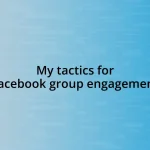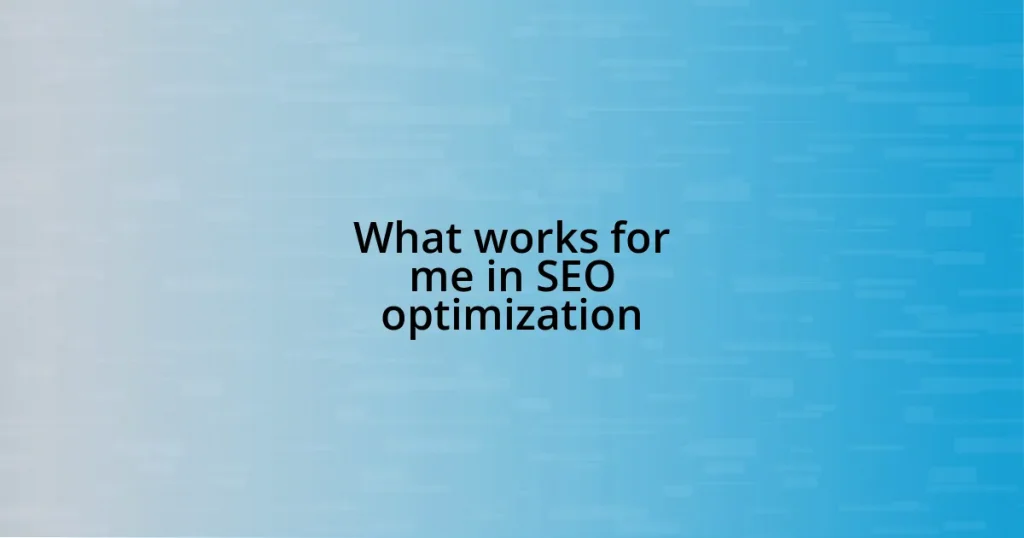Key takeaways:
- Effective collaboration enhances creativity, trust, and problem-solving among team members.
- Understanding team dynamics, including roles and emotional intelligence, fosters unity and accountability.
- Clear communication through openness and active listening transforms team dynamics and enhances engagement.
- Celebrating achievements and acknowledging individual contributions boosts morale and fosters a positive team culture.

Importance of Effective Collaboration
Effective collaboration is crucial because it amplifies creativity and innovation. I remember a project where brainstorming sessions with my team led to unexpected ideas that none of us could have arrived at alone. Isn’t it incredible how different perspectives can ignite a spark of creativity?
When team members work together, they build trust and camaraderie, which fosters a positive work environment. I’ve felt firsthand how collaboration can lighten the load when we divide tasks according to each person’s strengths and skills. Isn’t it empowering to see how collective effort can lead to success?
Not to mention, problem-solving becomes so much easier in a collaborative setting. I once faced a challenging issue at work, and rather than struggling alone, I invited the team to brainstorm solutions. The relief and satisfaction we all felt when we solved it together was incredibly refreshing. Have you ever experienced the power of teamwork in such a way?

Understanding Team Dynamics
Understanding team dynamics is essential for successful collaboration. I’ve observed that each team member brings unique strengths, viewpoints, and personalities to the table. For instance, in a recent project, we had a mix of analytical thinkers and creative types, which continuously sparked debates but ultimately led to richer outcomes. It’s fascinating how understanding these differences can transform potential conflicts into opportunities for growth.
Here are a few key aspects of team dynamics to keep in mind:
- Roles and Responsibilities: Clearly defined roles help prevent confusion and ensure accountability.
- Communication Styles: Recognizing how each team member communicates can enhance clarity and decrease misunderstandings.
- Emotional Intelligence: Teams that cultivate empathy and awareness create an environment of trust, making collaboration smoother and more enjoyable.
Navigating these elements has its challenges, but I’ve found that embracing them fosters a sense of belonging and unity within the team. When I took the time to understand my teammates’ emotions and motivations during a particularly stressful deadline, we not only met our goals but also deepened our relationships, something I genuinely cherish.

Establishing Clear Communication
Establishing clear communication is the backbone of effective collaboration. I’ve learned that being transparent about thoughts and feelings fosters a culture of openness. For example, during a recent project, we made it a point to share our challenges regularly, which helped us avoid misunderstandings and united us around common goals. Have you ever noticed how simply speaking up can clear the air and empower a team?
Another aspect I find vital is to actively listen. Listening isn’t just about hearing the words; it’s understanding the meaning behind them. I remember a time when a colleague expressed doubt about a strategy we were pursuing. Instead of dismissing his concerns, we took the time to address them together, leading to a more robust plan that incorporated his valuable insights. That experience reinforced for me how listening can lead to better outcomes and a more inclusive environment.
Finally, consider using a mix of communication tools to suit different preferences. Some team members thrive on face-to-face discussions, while others may prefer written messages for clarity. I’ve experimented with this approach in my teams, including tools like Slack for quick chats and Zoom for more in-depth discussions. This flexibility not only accommodates everyone’s style but also increases engagement and collaboration. Isn’t it refreshing to find a rhythm that works for everyone involved?
| Communication Aspect | Effective Strategy |
|---|---|
| Transparency | Share challenges openly |
| Active Listening | Understand the meaning behind words |
| Communication Tools | Use various platforms to suit preferences |

Setting Shared Goals and Objectives
Setting shared goals and objectives is crucial for unifying a team’s efforts. I remember working on a community project where we took the time to brainstorm and outline our shared objectives at the very beginning. This collaborative approach helped us not only align our individual aspirations but also created a sense of ownership. Have you ever noticed how much more invested people feel when they can directly influence the goals they’re working towards?
In another instance, I was part of a team that set SMART goals—Specific, Measurable, Achievable, Relevant, and Time-bound. Every week, we revisited these goals to reflect on our progress and address any potential roadblocks. This practice transformed our meetings from routine check-ins into enriching discussions that fostered accountability. It was incredible to see how clarity in our shared goals motivated everyone to push their limits and celebrate small victories along the way.
One key takeaway from these experiences is the importance of revisiting and adjusting goals as necessary. In a recent collaboration, we faced unexpected challenges that required us to pivot. Instead of seeing this as a setback, we saw an opportunity to refine our objectives. This adaptability not only kept the momentum going but also reinforced our commitment to the project and to each other. Have you experienced a similar evolution in your projects? It’s truly rewarding to see how shared goals can evolve and strengthen team cohesion.

Utilizing Collaborative Tools
Utilizing collaborative tools can enhance team synergy and streamline workflows in remarkable ways. I remember diving into a project management platform that transformed the way my team organized tasks. By assigning responsibilities and setting deadlines in a visual format, we not only improved our efficiency but also reduced the anxiety that often comes with juggling multiple assignments. Have you ever felt overwhelmed by tasks? Using these tools can lighten that load.
In my experience, incorporating tools like Google Drive for document sharing opened new doors for real-time collaboration. I vividly recall a brainstorming session where team members simultaneously edited a proposal document. The excitement of watching ideas evolve in real time left us feeling invigorated and focused. Isn’t it wonderful how technology can bring people together, regardless of location or time zone?
Lastly, I found that regular check-ins through collaborative tools help maintain momentum. For instance, we began scheduling weekly virtual coffee breaks where we casually discussed our progress and challenges using a shared platform. This relaxed setting not only helped us troubleshoot issues but also fostered stronger relationships among team members. Have you ever had those moments where informal interactions sparked profound breakthroughs in your work? They can be incredibly valuable for nurturing a sense of community.

Encouraging Feedback and Adaptability
Encouraging feedback is essential in any collaborative setting. I recall a project where we built a culture of open communication by inviting team members to share their thoughts after each meeting. Initially, some were hesitant, but as we emphasized that every voice mattered, the atmosphere shifted. Have you ever been part of a team where feedback made a significant difference? It can really transform the dynamics, allowing everyone to feel more included and invested.
Adaptability often stems from this feedback-rich environment. There was a time when a suggestion from a quieter team member changed the course of our strategy completely. Their fresh perspective not only salvaged a failing approach but also united the team around a new vision. It made me realize how crucial it is to be open to change and ready to pivot. When was the last time you adapted your plan based on someone else’s input? Embracing these moments of adaptability can lead to unexpected solutions and innovations.
To truly harness the power of both feedback and adaptability, create safe spaces for discussion. In one of my teams, we developed a practice of anonymous feedback forms where people could share their thoughts without fear of judgment. The insights we gained were profound and often sparked valuable conversations. It’s fascinating how such small gestures can significantly enhance trust and collaboration. Have you considered how your team might benefit from a similar approach? You might be surprised at the impact it could have.

Celebrating Team Achievements
Celebrating team achievements is more than just a pat on the back; it’s about creating a shared sense of accomplishment and motivation. I remember when we successfully launched a project that had consumed our time and energy for months. We took the time to host a virtual celebration, complete with some fun games and even a trivia quiz about the challenges we had faced. That day wasn’t just about acknowledging our hard work; it reminded us of the journey we had taken together. Isn’t it incredible how such moments can rekindle our passion for collaboration?
In my experience, I found that recognizing individual contributions within the context of team success can really boost morale. After one particularly grueling quarter, we organized a special meeting to spotlight everyone’s efforts. I still recall how the shyest member of our team beamed with pride when their innovative idea was highlighted. Watching that recognition unfold was a powerful reminder of how important it is to validate each person’s role in the larger picture. Have you ever witnessed the shift in energy when someone feels truly acknowledged?
Moreover, I believe that celebrating small victories can lead to a culture of positivity and resilience. During one project, we instituted a practice of sharing weekly “wins,” whether big or small, in our team chat. One week, a team member celebrated finishing a daunting report ahead of schedule. The ripple effect of that simple acknowledgment created an atmosphere where everyone felt inspired to share their own milestones. Isn’t it interesting how these little celebrations can enhance not just individual satisfaction but collective spirit?















